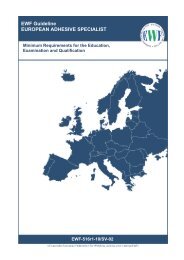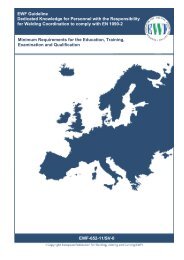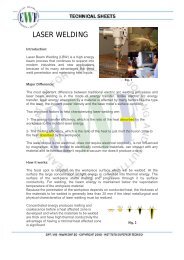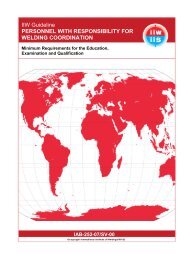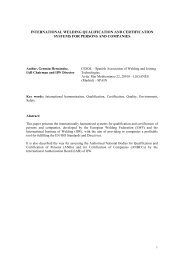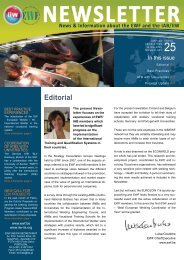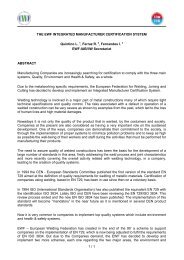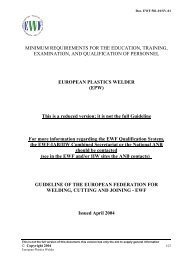Design of Outfit Elements in Ships for Fatigue Technical ... - EWF
Design of Outfit Elements in Ships for Fatigue Technical ... - EWF
Design of Outfit Elements in Ships for Fatigue Technical ... - EWF
You also want an ePaper? Increase the reach of your titles
YUMPU automatically turns print PDFs into web optimized ePapers that Google loves.
Repr<strong>in</strong>t<strong>in</strong>g and copy<strong>in</strong>g, even <strong>in</strong> the <strong>for</strong>m <strong>of</strong> excerpts, only with the consent <strong>of</strong> the publisher<br />
Bearbeiter: Osenberg<br />
File: D:\Eigene Dateien\Kunden\DVS\Ri+Me\3501\e3501.fm<br />
Erstellt am: 26.08.2004<br />
Zuletzt geändert am: 28.08.2004<br />
DVS – DEUTSCHER VERBAND<br />
FÜR SCHWEISSEN UND<br />
VERWANDTE VERFAHREN E.V.<br />
Preface<br />
At the suggestion <strong>of</strong> Work<strong>in</strong>g Group AG A 6.2 “Damages <strong>in</strong> welded<br />
Ship Structures” <strong>in</strong> the DVS – Deutscher Verband für Schweißen<br />
und verwandte Verfahren e.V. the <strong>Technical</strong> Bullet<strong>in</strong> “<strong>Design</strong><br />
<strong>of</strong> <strong>Outfit</strong> <strong>Elements</strong> <strong>in</strong> <strong>Ships</strong> <strong>for</strong> <strong>Fatigue</strong>” has been worked<br />
out.<br />
The <strong>Technical</strong> Bullet<strong>in</strong> is based on the results <strong>of</strong> the research<br />
project “Beanspruchungsgerechte Gestaltung von Ausrüstungselementen<br />
an der tragenden Schiffskonstruktion (<strong>Design</strong> <strong>for</strong><br />
Strength <strong>of</strong> <strong>Outfit</strong> <strong>Elements</strong> at the Load-carry<strong>in</strong>g Ship Structure)”<br />
(Author: Dr.-Ing. J. Roerup, Head <strong>of</strong> Dept.: Pr<strong>of</strong>. Dr.-Ing. H.<br />
Petershagen). The project was conducted at the <strong>Technical</strong> University<br />
Hamburg-Harburg and was f<strong>in</strong>ancially supported by the<br />
Arbeitsgeme<strong>in</strong>schaft <strong>in</strong>dustrieller Forschungsvere<strong>in</strong>igungen “Otto<br />
von Guericke” e.V. (AIF). For details reference is made to the<br />
Research Report No. 295/2001 <strong>of</strong> the Center <strong>of</strong> Maritime Technologies<br />
(CMT), Hamburg.<br />
The Work<strong>in</strong>g Group wishes to make this <strong>Technical</strong> Bullet<strong>in</strong> available<br />
to the shipyards as an aid <strong>in</strong> the design and arrangement <strong>of</strong><br />
outfit elements <strong>in</strong> load-carry<strong>in</strong>g ship structures. The Work<strong>in</strong>g<br />
Group is <strong>in</strong>terested <strong>in</strong> receiv<strong>in</strong>g feedback from its application together<br />
with suggestions <strong>for</strong> its improvement, which may be considered<br />
and <strong>in</strong>corporated <strong>in</strong> subsequent versions.<br />
Germanischer Lloyd (GL) has contributed to this work by advis<strong>in</strong>g<br />
and will, as far as applicable, use this <strong>Technical</strong> Bullet<strong>in</strong> <strong>in</strong> the<br />
assessment <strong>of</strong> structures presented <strong>for</strong> approval. GL, however,<br />
reserves the right <strong>of</strong> decisions deviat<strong>in</strong>g from its contents <strong>in</strong> <strong>in</strong>dividual<br />
cases.<br />
This publication has been prepared by a group <strong>of</strong> experts <strong>in</strong> honorary<br />
co-operation and is recommended <strong>for</strong> consideration as an<br />
important source <strong>for</strong> <strong>in</strong><strong>for</strong>mation. The user must always check to<br />
what extent its contents are applicable to his particular case and<br />
whether the version <strong>in</strong> hand is still valid. Responsibility cannot be<br />
accepted, neither by DVS nor by those hav<strong>in</strong>g participated <strong>in</strong> the<br />
preparation <strong>of</strong> the <strong>Technical</strong> Bullet<strong>in</strong>.<br />
Catalogue <strong>of</strong> Details <strong>in</strong> <strong>Outfit</strong> <strong>Design</strong><br />
With this catalogue data <strong>for</strong> the fatigue assessment <strong>of</strong> outfit design<br />
elements made <strong>of</strong> steel are provided <strong>for</strong> practical application.<br />
In the preparation <strong>of</strong> the catalogue the results <strong>of</strong> the project<br />
“Beanspruchungsgerechte Gestaltung von Ausrüstungselementen<br />
an der tragenden Schiffskonstruktion (<strong>Design</strong> <strong>for</strong> Strength <strong>of</strong><br />
<strong>Outfit</strong> <strong>Elements</strong> at the load-carry<strong>in</strong>g Ship Structure)” as well as<br />
data from other sources are used. The catalogue is arranged with<br />
a view to an extension by additional elements <strong>in</strong> the future.<br />
<strong>Design</strong> <strong>of</strong> <strong>Outfit</strong> <strong>Elements</strong><br />
<strong>in</strong> <strong>Ships</strong> <strong>for</strong> <strong>Fatigue</strong><br />
The catalogue has been worked out <strong>in</strong> close co-operation with<br />
Germanischer Lloyd (GL) and is based on the Rules <strong>of</strong> GL. For<br />
further <strong>in</strong>terest it will be decided at a later date whether Rules <strong>of</strong><br />
other Classification Societies will be considered.<br />
The fatigue assessment corresponds <strong>in</strong> actual <strong>in</strong>dividual cases to<br />
that accord<strong>in</strong>g to GL-Rules Issue 2003 (Rules <strong>for</strong> Classification<br />
and Construction, I-Ship Technology, Part 1 - Seago<strong>in</strong>g <strong>Ships</strong>,<br />
Chapter1 - Hull Structures, Section 20 - <strong>Fatigue</strong> Strength). Accord<strong>in</strong>gly<br />
it must be proven that ∆σmax ≤ ∆σp. In this ∆σmax is the<br />
largest stress range expected dur<strong>in</strong>g the service life and ∆σp the<br />
permissible stress range. ∆σp is obta<strong>in</strong>ed by multiply<strong>in</strong>g the detail<br />
category with a number <strong>of</strong> coefficients tak<strong>in</strong>g stress spectrum,<br />
mean stress, material, weld shape (postweld treatment) and<br />
significance <strong>of</strong> the structural part <strong>in</strong>to consideration. Details are<br />
given <strong>in</strong> the GL-Rules mentioned above.<br />
It is further assumed that the welds between outfit elements and<br />
structural members meet the quality requirements <strong>for</strong> load-carry<strong>in</strong>g<br />
ship structures (see e. g. the GL-Rules mentioned above).<br />
The calculation <strong>of</strong> maximum permissible stresses <strong>in</strong> ship hulls is<br />
not expla<strong>in</strong>ed <strong>in</strong> detail <strong>in</strong> this document. It is assumed that<br />
respective data are available to the user. As these data will be<br />
determ<strong>in</strong>ed by means <strong>of</strong> structural design s<strong>of</strong>tware <strong>in</strong> most<br />
cases, this document is based on the widely spread program system<br />
POSEIDON as an example.<br />
With the application <strong>of</strong> the programme system POSEIDON the<br />
assessment is simplified to ∆σRperm ≤ ∆σR <strong>in</strong> way <strong>of</strong> longitud<strong>in</strong>al<br />
structures. The lowest permissible detail category ∆σRperm with<br />
regard to the expected service load is then determ<strong>in</strong>ed with<strong>in</strong> the<br />
program. The user then can f<strong>in</strong>d by means <strong>of</strong> the detail category<br />
the permissible outfit details <strong>for</strong> the area <strong>of</strong> the load-carry<strong>in</strong>g ship<br />
structure <strong>in</strong> question from the catalogue without any further<br />
calculation. Fig. 1 shows a record with lowest permissible detail<br />
categories <strong>for</strong> the plate panels <strong>in</strong> way <strong>of</strong> a midship section. Because<br />
<strong>of</strong> the higher-tensile steel applied and correspond<strong>in</strong>g higher<br />
permissible stresses <strong>in</strong> the strength deck outfit details with<br />
detail categories below ∆σR = 50 are not allowed <strong>in</strong> this area. In<br />
certa<strong>in</strong> areas such as hatch coam<strong>in</strong>gs even higher detail categories<br />
are necessary with regard to the exist<strong>in</strong>g stress level. In addition<br />
to the ∆σRperm <strong>for</strong> plate panels POSEIDON also determ<strong>in</strong>es<br />
the respective value <strong>for</strong> longitud<strong>in</strong>al stiffeners. It must be noted<br />
that at present only stresses due to vertical and horizontal hull<br />
bend<strong>in</strong>g and local bend<strong>in</strong>g <strong>of</strong> plates and stiffeners are considered<br />
<strong>in</strong> POSEIDON. Other possible stress components, e.g. by bend<strong>in</strong>g<br />
<strong>of</strong> grillage structures are not taken <strong>in</strong>to account. If such additional<br />
components are not considered <strong>in</strong> a separate calculation, it<br />
is recommended <strong>for</strong> the time be<strong>in</strong>g to <strong>in</strong>crease the lowest permissible<br />
detail category ∆σRperm by one category. The <strong>for</strong>mat <strong>of</strong> the<br />
detail catalogue corresponds largely to the catalogue <strong>of</strong> notch<br />
cases <strong>in</strong> the GL-Rules, issue 2003. The arrangement follows a<br />
selection <strong>of</strong> frequently used elements <strong>of</strong> outfit.<br />
This publication has been drawn up by a group <strong>of</strong> experienced experts <strong>in</strong> cooperative work on an honorary basis and it is recommended to pay attention to it as an<br />
important source <strong>of</strong> knowledge. The user must always check to what extent the contents can be applied to his/her special case and whether the version <strong>in</strong> his/her<br />
possession is still valid. Any liability on the part <strong>of</strong> the DVS and those people who have been <strong>in</strong>volved <strong>in</strong> the elaboration work is excluded.<br />
DVS, <strong>Technical</strong> Committee, Work<strong>in</strong>g Group ″Weld<strong>in</strong>g <strong>in</strong> Shipbuild<strong>in</strong>g and Mar<strong>in</strong>e Eng<strong>in</strong>eer<strong>in</strong>g″<br />
Orders to: DVS-Verlag GmbH, P. O. Box 10 19 65, 40010 Düsseldorf, Germany, Tel.: + 49(0)211/1591- 0, Fax: + 49(0)211/1591-150<br />
November 2004<br />
<strong>Technical</strong> Bullet<strong>in</strong><br />
DVS 3501
Page 2 <strong>of</strong> DVS 3501<br />
Comments<br />
Description <strong>of</strong> Type <strong>of</strong> connection Detail<br />
category<br />
∆σR Equipment Detail Sketch <strong>of</strong> connection with<br />
fatigue crack and stress<br />
considered σ<br />
Stress concentrations caused by the<br />
open<strong>in</strong>g to be considered as follows<br />
140<br />
(m0 = 4)<br />
Plate edges punched or mach<strong>in</strong>e-cut by means <strong>of</strong> a thermal<br />
cutt<strong>in</strong>g process. The cutt<strong>in</strong>g surface is free <strong>of</strong> cracks and<br />
notches. Cutt<strong>in</strong>g edges are chamfered or rounded<br />
1.1 Open<strong>in</strong>gs uniaxially loaded<br />
∆σmax = K1 ⋅ ∆σN bzw. ∆σRperm ≤ ∆σR /K t<br />
K t: Notch factor accord<strong>in</strong>g to GL Section 3<br />
∆σN: Nom<strong>in</strong>al stress range related to net<br />
section<br />
alternatively direct determ<strong>in</strong>ation <strong>of</strong> ∆σmax from FE-calculation, especially <strong>in</strong> case <strong>of</strong><br />
multiple arrangement <strong>of</strong> open<strong>in</strong>gs<br />
Plate edges which are not meet<strong>in</strong>g the above mentioned<br />
requirements, but are free from cracks and sharp notches<br />
125<br />
(m0 = 3.5)<br />
Mach<strong>in</strong>e cut or punched:<br />
or σ x >> σ y<br />
100<br />
(m0 = 3.5)<br />
Manually cut:<br />
Stress concentrations caused by the<br />
open<strong>in</strong>g to be considered as follows<br />
140<br />
(m0 = 4)<br />
Plate edges punched or mach<strong>in</strong>e-cut by means <strong>of</strong> a thermal<br />
cutt<strong>in</strong>g process. The cutt<strong>in</strong>g surface is free <strong>of</strong> cracks and<br />
notches. Cutt<strong>in</strong>g edges are chamferred or rounded<br />
1.2 Open<strong>in</strong>gs biaxially loaded<br />
∆σmax = K1 ⋅ ∆σN K t: Notch factor accord<strong>in</strong>g to Fig. 2<br />
∆σN : Nom<strong>in</strong>al stress range related to net<br />
section<br />
alternatively direct determ<strong>in</strong>ation <strong>of</strong> ∆σmax from FE-calculation, especially <strong>in</strong> case <strong>of</strong><br />
multiple arrangement <strong>of</strong> open<strong>in</strong>gs<br />
Plate edges which are not meet<strong>in</strong>g the above mentioned<br />
requirements, but are free from cracks and sharp notches<br />
125<br />
(m0 = 3.5)<br />
Mach<strong>in</strong>e cut or punched:<br />
100<br />
(m0 = 3.5)<br />
Manually cut:<br />
σ x ≈ σ y<br />
Stress concentrations caused by the<br />
open<strong>in</strong>g to be considered as follows<br />
140<br />
(m0 = 4)<br />
1.3 Open<strong>in</strong>gs shear-loaded Plate edges punched or mach<strong>in</strong>e-cut by means <strong>of</strong> a thermal<br />
cutt<strong>in</strong>g process. The cutt<strong>in</strong>g surface is free <strong>of</strong> cracks and<br />
notches. Cutt<strong>in</strong>g edges are chamferred or rounded<br />
∆σmax = K1 ⋅ ∆σN K t: Notch factor accord<strong>in</strong>g to Fig. 3<br />
∆σN : Nom<strong>in</strong>al stress range related to net<br />
section<br />
alternatively direct determ<strong>in</strong>ation <strong>of</strong> ∆σmax from FE-calculation, especially <strong>in</strong> case <strong>of</strong><br />
multiple arrangement <strong>of</strong> open<strong>in</strong>gs<br />
Plate edges which are not meet<strong>in</strong>g the above mentioned<br />
requirements, but are free from cracks and sharp notches<br />
125<br />
(m0 = 3.5)<br />
Mach<strong>in</strong>e cut or punched:<br />
100<br />
(m0 = 3.5)<br />
Manually cut:
Comments<br />
Description <strong>of</strong> Type <strong>of</strong> connection Detail<br />
category<br />
∆σR Equipment Detail Sketch <strong>of</strong> connection with<br />
fatigue crack and stress<br />
considered σ<br />
71<br />
63<br />
1.4 Pipe penetration Pipe penetrat<strong>in</strong>g a plate with circumferential fillet weld<br />
d ≤ 50 mm<br />
d > 50 mm<br />
Note:<br />
In case <strong>of</strong> large diameters an assessment based on local<br />
stresses is recommended<br />
Assessment correspond<strong>in</strong>g to doubl<strong>in</strong>g<br />
plate<br />
63<br />
56<br />
50<br />
1.5 Dra<strong>in</strong> plugs Dra<strong>in</strong> plugs accord<strong>in</strong>g to DIN 87721-1<br />
(Diameter about 190 mm)<br />
tD ≤ 0.8 t<br />
0.8 t < tD ≤ 1.5 t<br />
tD > 1.5 t<br />
For t2 ≤ 0.7 ⋅ t1 ∆σR can be upgraded by<br />
one category, however not beyond 80<br />
80<br />
71<br />
63<br />
56<br />
Stiffener welded to a plate <strong>in</strong> load<strong>in</strong>g direction<br />
R ≤ 50 mm<br />
50 mm < R ≤ 150 mm<br />
150 mm < R ≤ 300 mm<br />
R > 300 mm<br />
2.1 Holder <strong>in</strong> unsupported plate<br />
panel<br />
arranged parallel to ma<strong>in</strong> load<br />
80<br />
Stiffener welded to a plate transversely to load direction<br />
(valid <strong>for</strong> short and long stiffeners)<br />
2.2 Holder <strong>in</strong> unsupported plate<br />
panel<br />
arranged transverse to ma<strong>in</strong> load<br />
Page 3 <strong>of</strong> DVS 3501
Page 4 <strong>of</strong> DVS 3501<br />
Comments<br />
Description <strong>of</strong> Type <strong>of</strong> connection Detail<br />
category<br />
∆σR Equipment Detail Sketch <strong>of</strong> connection with<br />
fatigue crack and stress<br />
considered σ<br />
Fillet weld to plate panel loaded <strong>in</strong> bend<strong>in</strong>g Assessment <strong>in</strong> <strong>in</strong>dividual cases by means<br />
<strong>of</strong> hot spot stress concept with<br />
∆σSR = 90<br />
2.3 Holder <strong>in</strong> unsupported plate<br />
panel with or without doubl<strong>in</strong>g<br />
plate<br />
Application <strong>of</strong> a doubl<strong>in</strong>g plate can be necessary depend<strong>in</strong>g on the local stiffness result<strong>in</strong>g from the dimensions <strong>of</strong> plate panel, holder and doubl<strong>in</strong>g<br />
plate and from the position <strong>of</strong> the holder with<strong>in</strong> the plate panel.<br />
Example: Holder 60 mm × 15 mm, position <strong>of</strong> the holder <strong>in</strong> the center <strong>of</strong> the plate panel<br />
Permissible acceleration <strong>for</strong>ces F 2 <strong>in</strong> [N] <strong>for</strong> 1 m lever arm, (F 1 = 0)<br />
Location <strong>of</strong> crack <strong>in</strong>itiation<br />
Plate panel 1800 mm × 600 mm with t<br />
=<br />
10 mm 15 mm 20 mm<br />
Variant<br />
without doubler 1090 N 2680 N 5340 N plate to holder<br />
1940 N 4400 N 8000 N plate to doubler (1)<br />
2000 N 2120 N 2150 N doubler to holder (2)<br />
with doubler<br />
∅ = 100 mm<br />
t = 10 mm<br />
While the permissible <strong>for</strong>ce <strong>for</strong> a 10 mm thick plate panel is <strong>in</strong>creased by a factor <strong>of</strong> about 2 if a doubl<strong>in</strong>g is fitted, the permissible <strong>for</strong>ce <strong>for</strong> a 20 mm<br />
thick plate panel is by a factor <strong>of</strong> about 2,5 higher <strong>for</strong> the holder without doubl<strong>in</strong>g plate.<br />
<strong>in</strong>complete circumferential weld may be<br />
applied <strong>in</strong> dry spaces only.<br />
Unloaded overlapped plate fillet welded to longitud<strong>in</strong>ally<br />
loaded structural member<br />
2.4 Holder at stiffener<br />
Alternative 1<br />
For R > 150 mm ∆σR to be downgraded<br />
by one category, <strong>for</strong> R 50 mm ≤ ∆σR can<br />
be upgraded by one category<br />
56<br />
50<br />
– at bulb flat pr<strong>of</strong>ile or flat bar<br />
– at angle bar<br />
For structural members loaded by<br />
bend<strong>in</strong>g ∆σR to be downgraded by one<br />
category<br />
For t2 ≤ 0.7 ⋅ t1 ∆σR can be upgraded by<br />
one category, however not beyond 56.<br />
Plate welded to an edge <strong>of</strong> a plate or girder flange<br />
R ≤ 50 mm<br />
50 mm < R ≤ 150 mm<br />
150 mm < R ≤ 300 mm<br />
R > 300 mm<br />
2.5 Holder at stiffener<br />
Alternative 2<br />
For plates or girder flanges loaded <strong>in</strong> <strong>in</strong>plane<br />
bend<strong>in</strong>g ∆σR to be downgraded by<br />
one category<br />
56<br />
50<br />
45<br />
40
Comments<br />
Description <strong>of</strong> Type <strong>of</strong> connection Detail<br />
category<br />
∆σR Equipment Detail Sketch <strong>of</strong> connection with<br />
fatigue crack and stress<br />
considered σ<br />
Holder to be arranged <strong>in</strong> neutral axis <strong>of</strong><br />
stiffener if possible<br />
Stiffener welded to a plate <strong>in</strong> load direction<br />
R ≤ 50 mm<br />
50 mm < R ≤ 150 mm<br />
150 mm < R ≤ 300 mm<br />
R > 300 mm<br />
2.6 Holder at stiffener<br />
Alternative 3<br />
For t2 ≤ 0.7 ⋅ t1 ∆σR can be upgraded by<br />
one category, however not beyond 80<br />
80<br />
71<br />
63<br />
56<br />
80 The detail category is also valid <strong>for</strong> not<br />
fully circumferential welded holders (see<br />
2.4).<br />
Fillet-welded stiffener transverse to load<strong>in</strong>g direction (valid<br />
<strong>for</strong> short and long stiffeners)<br />
2.7 Holder at stiffener<br />
Alternative 4<br />
For stiffeners loaded <strong>in</strong> bend<strong>in</strong>g ∆σR to be<br />
downgraded by one category.<br />
In way <strong>of</strong> the rounded corner <strong>of</strong> an open<strong>in</strong>g<br />
with the radius r a m<strong>in</strong>imum distance x<br />
from the edge to be kept (hatched area):<br />
2.8 Holder at cut-out or open<strong>in</strong>g Holder welded <strong>in</strong> way <strong>of</strong> an open<strong>in</strong>g and arranged parallel<br />
to the edge <strong>of</strong> the open<strong>in</strong>g.<br />
x [mm] = 15 + 0.175 ⋅ r [mm]<br />
100 mm ≤ r ≤ 400 mm<br />
In case <strong>of</strong> an elliptical round<strong>in</strong>g the mean<br />
value <strong>of</strong> both semi-axes to be applied<br />
R ≤ 150 mm<br />
not valid <strong>for</strong> hatch corners<br />
Circular doubler plate with max. 150 mm diameter.<br />
tD ≤ 0.8 t<br />
2.9 Doubler plate <strong>for</strong> holder <strong>in</strong><br />
unsupported plate panel<br />
Page 5 <strong>of</strong> DVS 3501<br />
71<br />
63<br />
56<br />
0.8 t < tD ≤ 1.5 t<br />
tD > 1.5 t
Page 6 <strong>of</strong> DVS 3501<br />
Comments<br />
Description <strong>of</strong> Type <strong>of</strong> connection Detail<br />
category<br />
∆σR Equipment Detail Sketch <strong>of</strong> connection with<br />
fatigue crack and stress<br />
considered σ<br />
For t2 ≤ 0.7 ⋅ t1 ∆σR can be upgraded by<br />
one category, however not beyond 80<br />
80<br />
71<br />
Stiffener welded to a plate <strong>in</strong> load<strong>in</strong>g direction<br />
R ≤ 50 mm<br />
50 mm < R ≤ 150 mm<br />
3.1 Rail stanchions<br />
arranged parallel to the ma<strong>in</strong><br />
load<strong>in</strong>g direction<br />
80<br />
Stiffener welded to a plate transverse to the load<strong>in</strong>g<br />
direction<br />
3.2 Rail stanchions<br />
arranged transverse to the ma<strong>in</strong><br />
load<strong>in</strong>g direction<br />
80 The sketch shows the connection <strong>of</strong> a<br />
bollard to a deck. The ma<strong>in</strong> stress is<br />
approximately directed perpendicular<br />
towards the bollard wall <strong>for</strong> all angles<br />
3.3 Bollard Fillet-welded stiffener transverse to the load<strong>in</strong>g direction<br />
(valid <strong>for</strong> short and long stiffeners)<br />
For t2 ≤ 0.7 ⋅ t1 ∆σR can be upgraded by<br />
one category.<br />
56<br />
50<br />
Stiffener welded to a plate <strong>in</strong> load<strong>in</strong>g direction<br />
150 mm < R ≤ 300 mm<br />
R > 300 mm<br />
4.1 Foundations<br />
Ends <strong>of</strong> girders parallel to ma<strong>in</strong><br />
load<strong>in</strong>g direction<br />
80<br />
Fillet-welded stiffener transverse to the load<strong>in</strong>g direction<br />
(valid <strong>for</strong> short and long stiffeners)<br />
4.2 Foundations<br />
For girders tranverse to ma<strong>in</strong><br />
load<strong>in</strong>g direction
Comments<br />
Description <strong>of</strong> Type <strong>of</strong> connection Detail<br />
category<br />
∆σR Equipment Detail Sketch <strong>of</strong> connection with<br />
fatigue crack and stress<br />
considered σ<br />
For t2 ≤ 0.7 ⋅ t1 ∆σR can be upgraded by<br />
one category.<br />
Stiffener welded to a plate <strong>in</strong> load<strong>in</strong>g direction<br />
R > 300 mm 56<br />
Assessment <strong>of</strong> the open<strong>in</strong>g edges by<br />
means <strong>of</strong> a direct determ<strong>in</strong>ation <strong>of</strong> the<br />
notch factor only<br />
4.3 Small hatches<br />
Assessment <strong>of</strong> weld at transition<br />
from deck to coam<strong>in</strong>g <strong>in</strong> a hatch<br />
corner<br />
For t2 ≤ 0.7 ⋅ t1 ∆σR can be upgraded by<br />
one category.<br />
71<br />
63<br />
56<br />
Stiffener welded to a plate <strong>in</strong> load<strong>in</strong>g direction<br />
R ≤ 150 mm<br />
150 mm < R ≤ 300 mm<br />
R > 300 mm<br />
4.4 Conta<strong>in</strong>er foundations<br />
Assessment <strong>of</strong> girder end parallel to<br />
ma<strong>in</strong> load<strong>in</strong>g direction<br />
∆σR may be upgraded by one category:<br />
– re<strong>in</strong><strong>for</strong>ced end weld<br />
– weld angle ≤ 30°<br />
– connection length ≤ 150 mm<br />
End <strong>of</strong> a long doubler at the flange <strong>of</strong> a girder<br />
tD ≤ 0.8 t<br />
56<br />
50<br />
45<br />
0.8 t < tD ≤ 1.5 t<br />
tD > 1.5 t<br />
5.1 Hatch cover bear<strong>in</strong>gs (pads)<br />
Assessment with regard to load<strong>in</strong>g<br />
<strong>of</strong> ship structure<br />
Load-carry<strong>in</strong>g fillet weld Assessment <strong>in</strong> <strong>in</strong>dividual cases by means<br />
<strong>of</strong> hot-spot concept with ∆σSR = 90<br />
5.2 Hatch cover bear<strong>in</strong>gs (pads)<br />
Assessment with regard to<br />
conta<strong>in</strong>er loads<br />
Page 7 <strong>of</strong> DVS 3501
Page 8 <strong>of</strong> DVS 3501<br />
Comments<br />
Description <strong>of</strong> Type <strong>of</strong> connection Detail<br />
category<br />
∆σR Equipment Detail Sketch <strong>of</strong> connection with<br />
fatigue crack and stress<br />
considered σ<br />
Required throat thickness "a" <strong>of</strong> fillet<br />
welds related to weld penetration depth<br />
"e"<br />
80<br />
Stiffener arranged transverse to ma<strong>in</strong> load<strong>in</strong>g direction<br />
σ2 ≤ 0.4 σ1 Assessment to be based on σ 1 only<br />
5.3 Hatch cover lock<strong>in</strong>g device<br />
Arranged transverse to ma<strong>in</strong><br />
load<strong>in</strong>g direction<br />
αm<strong>in</strong> 0.82 t 1 2.8 e ⎛ –<br />
⎝<br />
-- ⎞<br />
t ⎠<br />
0.74<br />
=<br />
⋅ ⋅<br />
t: Thickness <strong>of</strong> lock<strong>in</strong>g device. Otherwise<br />
assessment as cruci<strong>for</strong>m jo<strong>in</strong>t<br />
Assessment with regard to biaxial load<br />
Assessment to be based on σ2 only<br />
Biaxially loaded fillet welded cruci<strong>for</strong>m jo<strong>in</strong>t, failure from the<br />
weld root.<br />
(reference stress to be determ<strong>in</strong>ed <strong>for</strong> the weld section) 30<br />
Assessment <strong>of</strong> unsupported hatch cover<br />
guide corner see 4.4.<br />
71<br />
63<br />
5.4 Hatch cover guide Detail welded to girder flange, bulb or plate with s<strong>of</strong>t<br />
transition (tapered end or radius); c ≤ 2 t2, max. 25 mm<br />
r ≥ 0.5 h<br />
r < 0.5 h or ϕ ≤ 20°<br />
ϕ > 20° as stiffener <strong>in</strong> load direction<br />
For t2 ≤ 0.5 t1 ∆σR may be <strong>in</strong>creased by one category.
Figure 1. Lowest permissible detail categories <strong>in</strong> the midship section <strong>of</strong> a conta<strong>in</strong>er vessel.<br />
Kt<br />
12<br />
10<br />
8<br />
6<br />
4<br />
2<br />
0<br />
l/a=2<br />
l/a=4<br />
l/a=1<br />
0 0.1 0.2 0.3 0.4 0.5<br />
r/a<br />
Figure 2. Notch factors K t <strong>for</strong> rounded rectangular open<strong>in</strong>gs under biaxial load.<br />
a<br />
σy<br />
l<br />
r<br />
σx = σy<br />
σx<br />
Page 9 <strong>of</strong> DVS 3501
Page 10 <strong>of</strong> DVS 3501<br />
Kt<br />
18<br />
16<br />
14<br />
12<br />
10<br />
8<br />
6<br />
4<br />
2<br />
0<br />
l/a=2<br />
l/a=4<br />
l/a=1<br />
0 0.1 0.2 0.3 0.4 0.5<br />
r/a<br />
Figure 3. Notch factors K t <strong>for</strong> rounded rectangular open<strong>in</strong>gs under shear load.<br />
Publications, Normative References<br />
Research Report No. 295/2001 Center <strong>of</strong> Maritime Technologies (CMT), Hamburg<br />
GL-Rules Issue 2003 Germanischer Lloyd, Hamburg<br />
DIN 87721-1 Ablassverschraubungen – Teil 1: Zusammenstellung, E<strong>in</strong>bau<br />
a<br />
l<br />
r



